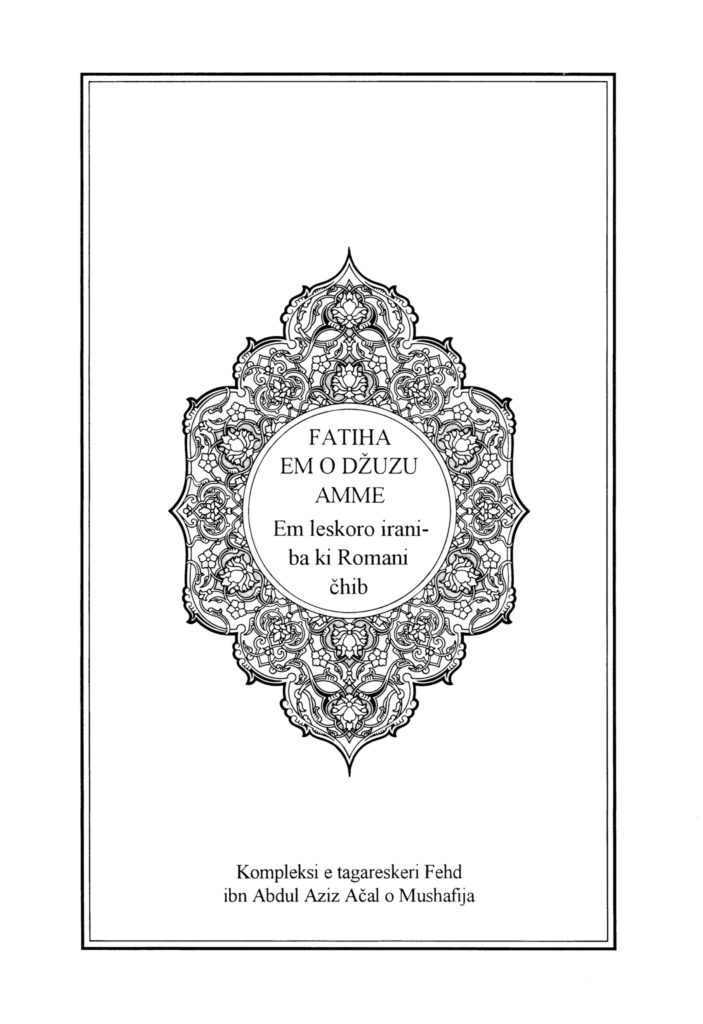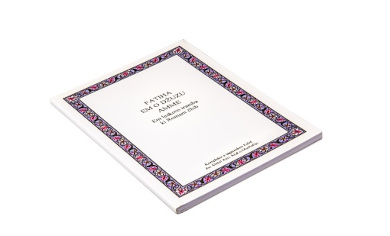In 1422/2002, the Saudi King Fahd Qur’an Printing Complex (KFQPC) advertised the publication of the first ever (partial) translation of the Qur’an into the language of the most marginalized community in Europe: the Roma, whose language, Romani, is spoken across Europe in many different varieties.
This event throws a spotlight on two important modern developments in Qur’an translation: First, the competition between various state and non-governmental actors to be the first to publish Qur’an translations into specific languages; and second, the desire of some translators and publishers to enhance the status of marginalized and predominantly orally used languages through the translation of scripture.
During the 1990s and 2000s especially, the KFQPC, which is funded by the Saudi state, strove to publish Qur’an translations into all kinds of languages, with a particular interest in covering languages into which the Qur’an had not previously been translated. In cases where the KFQPC were unable to find anyone to translate the entire Qur’an for them, they contented themselves with publishing a translation of the first surah (al-Fātiḥa) and the last of the 30 parts of the Qur’an (the juzʾ ʿamma), as was the case with their Fulani, Malagasy and Romani translations.
The KFQPC’s activity in the field of Qur’an translation, while remarkable, is not unrivalled. In the early years of the twentieth century, the Ahmadiyya movements, especially the Lahore Ahmadiyya, were already striving to make Qur’an translations available in many languages, and were in some cases the first to do so. In recent decades, a growing number of new private and state actors have been entering the market. Private enterprises include Goodword Books, founded in India and located in Turkey (see https://gloqur.de/quran-translation-of-the-week-101-global-dawa-in-french-and-the-gender-question-shahnaz-saidi-benbetkas-french-quran-translation-published-by-maulana-wahiduddin/), and the Riyadh-based publisher Darussalam.


However, efforts to identify languages into which the Qur’an has not been translated and produce the first ever translation in those languages are today mainly the domain of state actors. Similar to the KFQPC, the Turkish Directorate of Religious Affairs has initiated a Qur’an translation project and promoted it with the slogan ‘Hiçbir Lisan Kuransız Kalmasın’ (‘No language without a Qur’an’), a strategy which has led them to choose little-known target languages such as Chewa and Shona. Likewise, the Indonesian Ministry of Religious Affairs has been running a large-scale program of Qur’an translation into the many regional languages of Indonesia, such as Bantenese, Makassarese, Banyumasan and Palembang, for the last decade. One of the reasons for the domination of state-run organizations in this particular arena might be the limited demand for such translations into languages with relatively small readerships, which restricts both their commercial value and their usefulness in terms of daʿwah activities.
But then, there are other reasons than commercial value and daʿwah to produce a Qur’an translation, and the Romani translation ‘Fatiha em o džuzu Amme: Em leskoro iraniba ki Romani čhib’ is a good example of a translation borne of a different agenda. It was authored by the well-known Muslim Roma singer Muharem Serbezovski (b. 1950). Serbezovski was born in Skopje, then the capital of the Yugoslav Republic of Macedonia, which is a center for Muslim Roma. He became a successful singer at a young age, performing occasionally in Romani and Turkish, but mostly in Serbo-Croatian. From 1975, he lived in Sarajevo and later, after Yugoslavia fell apart, identified as Bosnian. During the 1980s, he started writing novels and poems and eventually continued his father’s work on a Romani (partial) Qur’an translation. He also claimed that he was planning to translate the Bible, hadiths, and some literary classics into Romani, an ambition which clearly hints at one of the main purposes of his translation project: elevating Romani to the status of a literary language, a process in which the translation of scripture has historically often been instrumental.
Romani is spoken in many countries across Europe, by adherents of various religions and denominations, but always as a minority language; it has no official status anywhere expect for some regions in the Republic of Kosovo and one municipality in Skopje, the capital of North Macedonia. Romani falls into a number of varieties that differ from each other in terms of vocabulary and grammar, and speakers of Romani are often stigmatized and assigned an inferior social status. Most Roma use Romani for oral communication but acquire literacy in the majority language of the country or region they live in. The same is true for the language use of Roma in religious settings, which is often dominated by the majority language, for example Macedonian, Turkish or Bosnian, although there has been an increase in the use of Romani since the 1950s. Most of that use is oral, though; it is not uncommon to find Romani preaching combined with readings from scriptural translations into a different language.
Muharem Serbezovski’s partial Qur’an translation was the first attempt to translate the Qur’an into Romani, or more specifically, the Balkan variant of Romani in Latin script. This ties in with a general increase in the production of Romani religious writings in recent decades, a development that is linked to the availability of new media and increased migration of Roma from the Balkans to Western Europe. As a result, translocal religious discourses in Romani have emerged, for example through religious preaching on YouTube. A case in point are the activities of the editor of Serbezovski’s Qur’an translation, Ali Berat, one of the most prominent Romani Islamic activists. The involvement of a religious scholar of some description in the translation project was a requirement on the part of the KFQPC, given that Serbezovski’s religious credentials might have seemed questionable to readers. Like Serbezovski, Berat hails from North Macedonia and is active there and in Bosnia, and his daʿwa organization ‘Islamsko Romani Dawetsko Organizacija,’ propagates Islamic teachings and practices among (nominally) Muslim Roma communities.

The translation itself is exegetical in style and, despite the author’s artistic background, makes no attempt to reproduce the Qur’an’s style or aesthetic. Serbezovski uses a comprehensible variety of Balkan Romani with few loanwords from present-day majority languages but does bring in a number of Arabic loanwords for religious terms in order to give the translation an Islamic flavor, for example ‘Allah’ rather than ‘Devel/ Del’ for God, ‘Šukureske’ or ‘Dženehem’ rather than ‘bengesko kher’ for hell, ‘Melekija’ rather than ‘Andjeo’ for angels, and so forth. Neither the translator nor the editor have made any attempt to introduce innovative interpretations, nor did they aim to propagate modernizing exegetical opinions. (Serbezovski caused a scandal in Bosnia 2009 by claiming that beating disobedient wives was part of Balkan tradition; it is therefore safe to say that he has no particular progressive leanings.)
As is the case with the potential audiences of many of the other ‘first Qur’an translations’ into less widespread languages, the group of Romani-speaking Muslims whom this translation addresses appears to be rather small. While there are probably around 3.5 million speakers of the Romani language, the majority of them are non-Muslims, and even among the Muslims, the proportion of practicing, religiously committed Muslims, while on the rise, remains small. Moreover, many Romani-speaking Muslims outside the Balkans have difficulty understanding the Balkan variety of Romani, unless they are migrants from the Balkans; but some of those nowadays speak Serbian or Bosnian or the language of their country of residence at home. Moreover, Romani has no standardized spelling and different alphabets are in use, with, for example the Cyrillic alphabet being used in Serbia, Bulgaria and parts of the former Soviet Union. That aside, many speakers of Romani are not used to reading and writing their language at all. Consequently, Serbezovski’s Qur’an translation seems to have very few readers.
This calls to mind an observation made by Wilco van den Heuvel on Romani Bible translation: ‘Notwithstanding the existence of many Romani Bible translations, there is little evidence that these translations are used to any great extent.’ He suggests ‘that the function of many Romani Bible translations is mainly “emblematic”: to show that Romani is a real language, worthy of having its own translated Bible’ (source: ‘The Palgrave Handbook of Romani Language and Linguistics’).
A similar phenomenon can be noted with regard to certain other Qur’an translation projects into minority languages. For example, a recent #qurantranslationoftheweek post on the Palembang Qur’an translation produced by the Indonesian Ministry of Religion noted that only 70 copies of this work have ever been printed (https://gloqur.de/quran-translation-of-the-week-99-the-state-sponsored-translation-of-the-quran-into-palembang-religious-moderation-and-language-dilemma/).
In the production of such translations, two interests converge, both of which are symbolic rather than practical: first, a desire on the part of the publisher to be the first to claim a particular language, thereby raising their own prestige as active proponents of Islam; and second, a desire on the part of certain representatives of the community of speakers to preserve their language, elevate it to the status of a literary language and contribute to its standardization.
These were clearly the motives behind the KFQPC’s partial Romani Qur’an translation: the KFQPC wanted to add another language to their portfolio of ‘first Qur’an translations’, and the translator, Serbezovski, wanted to contribute to the emancipation of the Romani languages from centuries of marginalization and from its status as an oral, or even ‘secret,’ language. These motivations went hand in hand with the daʿwa activities of some Romani Muslims in and from the Balkans, including the editor, Ali Berat; but even for religious activists, a translation of only the last juzʾ of the Qur’an is probably of limited use. As such, the production of ‘Fatiha em o džuzu Amme: Em leskoro iraniba ki Romani čhib’ is evidence of a phenomenon that is not entirely unusual in the field of Qur’anic exegesis, namely, that the act of producing the translation is performative. The creation of the translation creates a space for the negotiation of identity, regardless of whether and by whom the end result is ultimately used. By introducing the Romani language into the range of languages into which the Qur’an has been translated, it has been made visible as a Muslim language.
Johanna Pink
With heartfelt thanks for the invaluable input from Dislo Benjamin Harter, a German Muslim and native speaker of Romani!
